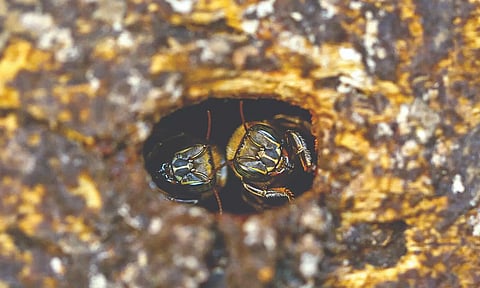

By Katrina Miller, RC Yacila
NEW YORK: As a child, Heriberto Vela, an Indigenous resident of Loreto, Peru, watched his father pull nests of wild stingless bees from trees in the Amazon forest. Together, the two then extracted honey from the nests to help cure colds and other ailments. Stingless bees are native to the Amazon, unlike the more familiar but invasive honey bees from Africa and Europe that have spread through the Americas. The most obvious difference, perhaps, is that stingless bees don’t sting. Their honey, which is runny enough to be drunk like a liquid and is said to have a citrusy after-taste, is used by many Indigenous Peruvians as a natural medicine.
Vela’s father didn’t know how to salvage the bees — they would fly away, or even die. “We would take the nests out and leave them lying on the ground in the forest,” Vela said. “Those bees were lost.”
Today, Vela’s methods are more sophisticated. His family keeps 76 nests of stingless bees in square wooden boxes perched on sticks and scattered around his home. Each artificial nest has multiple drawers, but Vela only harvests honey from one, which he calls the mielera, or honey pot, leaving the rest for the bees. “They need it to live,” he explained. “If I take it away from them, they may flee.”
The Amazon is home to hundreds of species of stingless bee, but as deforestation converts the tropical landscape into farms and ranches, these and other native pollinators are in danger of disappearing. Pesticides, climate change and competition with the honey bee, which is better adapted to agricultural areas than the stingless bee, introduces more strain. Vela’s family is among the few who keep stingless bees and live off the income they provide. Cesar Delgado, an entomologist at the Peruvian Amazon Research Institute who helped Vela refine his practice, wants to widen the appeal. “Beekeeping is a good way for the forest and communities to adapt to climate change,” he said.
Building an economy around stingless bees, which pollinate much of the Amazon’s native flora, is a creative way to fight deforestation, said Rosa Vasquez Espinoza, a chemical biologist and founder of Amazon Research Internacional. But for the effort to work, Dr. Vasquez Espinoza stressed, it must incorporate the knowledge and ways of life of the Indigenous peoples who call the rainforest home. It must be “a process that is self-sustaining, and aligned with the culture of the communities,” she said.
The Amazon is one of the most biodiverse regions in the world. But widespread deforestation threatens the protection of Indigenous communities as well as the animals and plants that live there, and it reduces the habitat’s function as a major carbon sink amid Earth’s growing climate crisis. “We are losing species that have never even been documented,” said Adrian Forsyth, a tropical ecologist who founded the Andes Amazon Fund and is not involved in the bee-keeping effort. “It’s not just that we’re burning the book of life,” he added. “It’s that we haven’t even read the first few pages.”
A sustainable conservation program requires funding, government backing, and the integration of local knowledge and practices, Dr. Forsyth said. There also needs to be some incentive beyond basic conservation. “People don’t value biodiversity for its own sake,” said Dr. Forsyth, adding that to get the message through, conservationists need to highlight how the goal relates to the general public. “Without pollination, you don’t get good crop yields. Without honey, you don’t have a good cup of tea.”